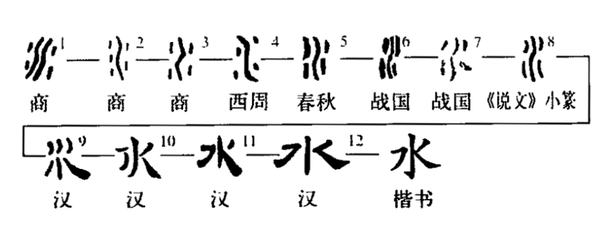Although I’m a science guy, I’ve always been fascinated by language and writing.
The symbol “~” is called a “波浪号” (bōlàng hào) in Chinese, which literally means “wave mark.”
Its official name is “浪纹” (làng wén), or “wave pattern.”
As you can see, Chinese is indeed a pictographic language—this symbol really does resemble waves on water.
In fact, the Chinese character for “water” (水) evolved from a similar shape.

(The character ‘water’, has evolved step by step into its current form over thousands of years.)
Speaking of water, there’s a very common Chinese radical called “三点水” (sān diǎn shuǐ), which means “three drops of water.” It’s essentially the ancient oracle bone script version of the character for water.
Speaking of “water,” it reminds me of something Mr. Zhao Yuanren, the father of modern Chinese linguistics, once said.
Around 1920, an elderly woman in Beijing told him that there was one thing she could never understand: why do Westerners call water “窝德”(water)?
It was simply unbelievable to her!
(Zhao himself was proficient in many languages, with 7 foreign languages at a native level and over 30 difficult dialects. He recorded this incident, possibly to show how people with no knowledge of foreign languages perceive them!)
Now, back to the wave mark (~).
According to the National Standard for Punctuation Marks of the People’s Republic of China, it has two grammatical functions:
- As a delimiter: It acts like a hyphen (“-“) but is specifically used to connect a range of Arabic numbers, such as “1~200” or “35.6%~55.9%.”
- As an onomatopoeic mark: It indicates the prolongation of a sound. Unlike the long dash (“——”), which also represents sound elongation, the wave mark (~) adds a sense of fluctuation or playfulness to the sound.
For example:
- “啊——” (ā——) – “Ah—” The enemy let out a scream and died!
- “哥哥~~哥哥~~你看我好不好看啊?” (Gēge~~ gēge~~, nǐ kàn wǒ hǎo bù hǎo kàn a?) – “Brother~~ brother~~, do I look pretty?”
(In China, it’s very common for romantic partners to call each other “哥哥” (gēge, older brother), “姐姐” (jiějie, older sister), or “妹妹” (mèimei, younger sister) as terms of endearment.)
~~我是分割线~~
(~~ I am the divider~~)
In everyday life, there’s another common use for the wave mark, as shown above.
Chinese people, especially younger generations, love to emphasize “segments” in text, as if they’re afraid readers might miss them.
Finally, and most commonly, the wave mark is used as an emoticon.
For example: ~。~ or ~,~
As you can see, it represents eyes or eyebrows.
Young people really enjoy using it this way.
Even the ancient Chinese character “囧” , which originally meant “window,” has been revitalized as an emoticon.
I suspect that in a few years, “囧” will completely lose its original meaning “windows”,and be solely associated with expressions like “awkward” or “helpless.”
But whether it’s a window, awkwardness, or helplessness, it all reinforces what I said earlier:
At its core, Chinese is a pictographic language!
(By the way, the character for pictographic (象),”elephant” (象) in Chinese also means “image” or “form” or “similar,looks like” In ancient times, it looked like this:

(The character ‘elephant,smilar’, has evolved step by step into its current form over thousands of years.)
By the way, in English, this symbol ~ is called “tilde.”
I feel like it has a connection to waves as well, since both the pronunciation and the shape of “tilde” are quite close to “tide.”
right ?